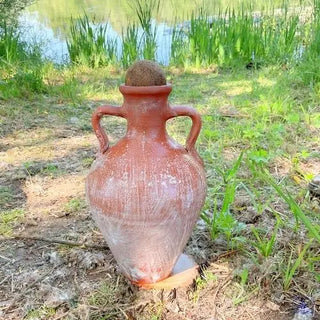Whether you are using a clay amphora to purify and store drinking water, for dry food storage or even as a decoration, from time to time you will need to clean it. The same goes for any terracotta clay article, be it a plant pot, or a cooking dish. In this article, we focus on our Clay Amphoras because we know that thousands of customers have bought them from us to improve the quality of their tap water.
Over time dust, air pollution, grease, fingerprints and limescale will accumulate on the surface of the clay and on the cork closure. Both the clay vessel and the cork can easily be cleaned. In this article, we give detailed instructions on how to clean an amphora and instructions on how to give an amphora a sun bath.

Please note, the inside of the amphora is totally self-cleaning and the inside only needs rinsing from time to time. Never put your hands or any kitchen tools inside the amphora. It is only the outside of the amphora which needs cleaning.
If the clay vessel is being used to store water and the atmospheric conditions are wrong, mildew (black spots of fungus) can form. This is unsightly and can ultimately impart malodour to the water and effect the flavour and health giving benefits of the water. The amphora will need to be relocated to a drier, airier location to prevent the formation of mildew. While this is unlikely to be an ongoing issue, if you do see signs of mildew, cease using the amphora until you have cleaned it.
It is important to use water based cleaners, and especially those which are non-toxic. This precludes most commercial cleaners and washing up liquids because they contain oils, colours, fragrances and many other chemicals.
We recommend using a plant grown water based detergent – we like to use Organic Soapnuts. This Soapnut liquid is a natural detergent which removes dust, pollutants, grease, sweat, and to some degree limescale. Soapnuts come as a dried tree fruit. When water is added, the natural soap or saponins contained in the skin of the dried tree fruit dissolve. It is the easiest soap to make at home. Just add water to the Soapnuts and let them soak until the liquid turns an amber colour. If you wish to speed up this soaking process, add warm or hot water.
We also add Citric Acid into the Soapnut Liquid – the citric acid dissolves very easily and it is very good at removing limescale.
Use a Scrubby, a rough textured cotton cleaning pad to apply and work the detergent.
1. Remove any water and rinse out the inside of the amphora with fresh water.
2. Wet the outside of the amphora and use the Scrubby to apply the Soapnut and Citric Acid detergent. The Scrubby is agile enough to clean the handle and the neck of the amphora.
3. Leave the soapy solution on the amphora to give it a chance to break down the limescale and then apply some more of your detergent with the Scrubby to help mechanically remove the limescale.
4. Rinse the amphora and allow it to dry completely before reusing it.
5. When the amphora is used for water purification, it is kept on a saucer or bowl which retains any run off. Be sure to clean the bowl at the same time, again using the same detergent and the Scrubby.
At this stage, while the amphora is still wet, it will likely look pristine, however as the amphora dries, some light coloured stains caused by minerals in the water will reappear. Don’t be concerned, the amphora will have been thoroughly cleaned, and these mineral deposits are present on every used amphora.
1. Follow the steps using Soapnuts, Citric Acid and the Scrubby as outlined above. If any traces of mildew remain, move onto the next step.
2. Either rub the dry amphora with a fine grade of sandpaper until the marks vanish or add clean sand to the Scrubby and rub the effected area until it is clean.
1. Use the same Soapnut and Citric Acid detergent as you used for cleaning the amphora and clean the cork with a Scrubby.
2. Place the cork in a clean vegetable steamer and steam for 3-5 minutes. At this stage the cork will be soft and wet.
3. Allow the cork to dry before using it on the amphora again.
The need to clean the amphora varies in frequency depending on usage, water quality, atmospheric conditions, the temperature and humidity in your home etc.
If the amphora is left standing in water, the base may become quite slippery, and the base should be wiped as you notice it. It is a good idea to check the bowl as well and to empty any water out of the bowl when you refill the amphora.
It is best to try to give the amphora a thorough clean at least once a month.
While your home-made detergent cleans the outside of the amphora and the cork, giving the amphora a sun bath freshens the amphora in a different way.
The sun, is nature’s free germicide. Not only does it kill germs and moulds, it also eliminates odours.
In addition, the heat of the sun expands the clay body of the amphora and cleans the pores in the clay wall.
We recommend giving your amphora a sun bath every few months. Even during the winter, the sun can really help freshen an amphora.
1. First of all thoroughly clean the amphora with a non-toxic water based detergent following the steps above.
2. Take the amphora outdoors and place it in its bowl, a tray or any clean surface. Please avoid metals and plastics. It is important not to place the amphora directly on the ground to prevent tainting the amphora with malodours. It is best to begin the sun bath a few hours before midday.
3. Make sure it is not windy, so the amphora doesn’t get blown over and make sure that it is positioned away from pets and children so that the amphora doesn’t get knocked over.
4. Leave the cork off the amphora but cover the mouth of the amphora with a clean handkerchief secured with string or a rubber band to prevent insects, leaves and dust entering the amphora, but so air can move in and out of the amphora.
5. Leave the amphora in the sun for a few hours, then as the sun moves across the sky, turn the amphora so that the side which has been in the shade, is now facing the sun. This assures that the sun’s rays strike both sides of the amphora.
6. Bring the amphora indoors if it starts to rain – you don’t want rainwater getting inside the amphora and you want to avoid the exterior of the amphora getting dirtied with rain and soil splashes.
Afterwards, bring the amphora indoors and you can start using it straight away.
Given that our Amphoras have no need or cartridges or replacement filters, keeping your amphora clean and airing it in the sun optimises the way the amphora conditions tap water. It assures that you get the most out of the amphora’s ability to purify, cool, store and energise tap water.
We hope that your will enjoy your amphora conditioned water day after day! If you would like to find out more about what our Amphoras can do for you, please read more on our Amphora page.


